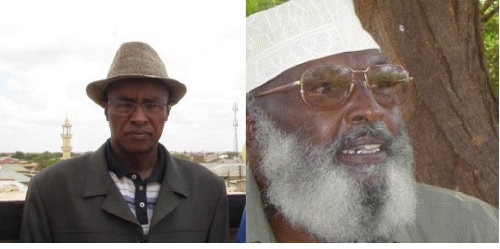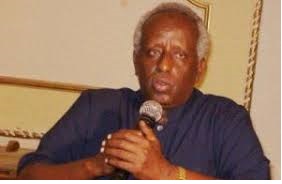By Liban Ahmad
During 1990 one of the most historically significant but underrated peace agreements was signed in the countryside of Balligubadle district in what was known as Northwest region, now Maroodijeex and under the jurisdiction of Somaliland Administration. A delegation led by Garad Abdiqani Garad Jama, one of the 1990 Somali Manifesto signatories, visited Balligubadle to formalise a peace agreement with Somali National Movement.

Although members of delegation (Mohamed Ali Ateye, Saeed Ali Giir, Ali Qamar, Aw Dahir Xaji and Bashe Ali Jama, a Manifesto signatory) might give the impression that Garad Abdiqani represented one Somali social group, the terms of the agreement reflect principles to which all Northerners were committed regardless of clan identity to promote peace among Somalis in general.
In 1990 Bura’o and Hargeisa, two cities that bore brunt of the civil war, had remained inhospitable. Inhabitants in both cities, who fled the war either to other parts of Somalia or crossed the border to become refugees in Ethiopia, had not returned to the two cities. The Somali government was increasingly losing the battle to control the cities due to new armed opposition movements that emerged in Southern Somalia.
A series of meetings preceded the Balligubadle Agreement. The first meeting was held in Qararro between 10 and12 of February, 1990. Four more meetings took place at Dannood (15-16 of February, 1990), Gawlaalle (20-22 of February, 1990), Gaashaamo (20-22 of August, 1990) and Wanaagsan (6th of September, 1990).

Those meetings provided the basis for the Balligubadle Agreement signed on 26th of September, 1990. Boobe Yusuf Du’ale signed the Agreement on behalf of SNM Chairman, Abdirahman Ahmed Ali; Garad Abdiqani signed on behalf of the visiting delegation representing non-SNM-supporting northern clans.
The core articles of the agreement emphasise the sanctity of the human life, the responsibility of politicians to prevent reprisals either by government forces or rebels and the property rights of citizens.
Unlike Balligubadle Agreement signatories, the 1990 Manifesto signatories laid the stress on how the military regime’s policies have resulted in mayhem in Somalia. They recommended measures that could lead to a democratic dispensation in Somalia. Well-meaning though signatories were, their intervention turned a blind eye to armed opposition organisations seeking to effect a political change in Somalia. Some signatories were active members of armed opposition groups. Ali Mahdi Mohamed, whom United Somali Congress installed as an Interim President in 1991, was a member of USC Central Committee. Mohamed Abshir Muse, a former Commander of Somali Police Force, went on to lead the reconstituted Somali Salvation Democratic Front.
Balligubadle signatories foresaw the situation in post-dictatorship Somalia. It is one of the reasons why Balligubadle Agreement signatories prepared their communities for post-dictatorship era to prevent widespread hostilities similar to the civil war that engulfed South Somalia after the fall of the military regime.
Several principles in the agreement stand out for the keen interest signatories had taken in peace-making for Somali communities affected directly or indirectly by the war between SNM forces and the Somali Army. The principle that “politics should guide the armed struggle” against the military regime saddled more responsibility with SNM leaders to raise consciousness of its fighters about the nature of the struggle and take responsibility for any transgressions or human rights violations that fighters might have perpetrated.
Freedom of movement for Somalis throughout Somalia is another principle that accented prevention of feuding. The promotion of reconciliation among Somali clans in “the Northwest and Awdal, and Sanaag and Sool” bound signatories to resolving any outstanding conflict in those regions since SNM aimed to overthrow a regime, not to let its fighters target citizens. The principle by which signatories operated to deal with known culprits who violated past agreements is another remarkable approach to conflict resolution in a highly volatile political situation. The common view that the SNM leadership and the members of the delegation shared on the military regime had facilitated the agreement.
It was easier for Northerners to build on Balligubadle Agreement to embark on subsequent peace-enhancing initiatives such as the 1993 Borama Conference and the 1995 Sanaag Reconciliation Conference.
Embedded in the Balliguabdle Agreement is the upholding of property rights, one of the foundations of peace in Somaliland. When politicians are reluctant to fully address property rights, as the case is in South Somalia, implementation of national reconciliation agreements faces formidable impediments.
Several reasons account for the successful implementation of Balligubadle Agreement, which has had a continued relevance for Somaliland Government. Firstly, SNM was the second, oldest Somali opposition organisation. Civilian leaders of the organisation were politicians conscious of traps into which the organisation could fall if they ignored the fact that human rights violations by SNM fighters result from political decisions. They accepted to be judged operationally by the standards that they would like the military regime leaders to be judged when it comes to human rights violations. Secondly, both SNM and the visiting delegation agreed that the conflict in Somalia is not traditional – one between clans living in the same locality. Ahmed Mohamed Silanyo alluded to this conception of conflict resolution when he, in his 1991 position paper, cautioned against reprisals against citizens for what a regime had done.
In South Somalia, where the United Somali Congress, which overthrew the military regime in 1991, and Somali Patriotic Movement, had been active, the Manifesto Group had a negligible impact on political outcomes due to focusing solely on the regime at the expense of another set of stakeholders – armed opposition groups.
Genuine peace-making and post-conflict reconstruction begins when political stakeholders take the responsibility to prevent the conflict from taking a direction that can either plunge the country into an internecine civil war or leave a legacy of intractable dispossession and displacements. A post-conflict stage requires candour, an earlier trust-building initiative and awareness of the risks that armed struggle against regime can go off track without periodic review of goals and operations alongside long-term objectives. This is a main lesson that the Balligubadle Agreement imparts to students of Somali politics and history.
Liban Ahmad
Email:[email protected]
——————
Reference
Heshiiska Balligubadle (The draft of the Agreement in Somali)
We welcome the submission of all articles for possible publication on WardheerNews.com. WardheerNews will only consider articles sent exclusively. Please email your article today . Opinions expressed in this article are those of the author and do not necessarily reflect the views of WardheerNews.
WardheerNew’s tolerance platform is engaging with diversity of opinion, political ideology and self-expression. Tolerance is a necessary ingredient for creativity and civility.Tolerance fuels tenacity and audacity.
WardheerNews waxay tixgelin gaara siinaysaa maqaaladaha sida gaarka ah loogu soo diro ee aan lagu daabicin goobo kale. Maqaalkani wuxuu ka turjumayaa aragtida Qoraaga loomana fasiran karo tan WardheerNews.
Copyright © 2024 WardheerNews, All rights reserved


